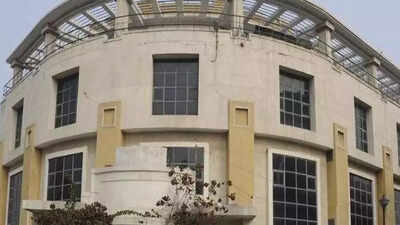- News
- City News
- gurgaon News
- Municipal Corporation of Gurugram seeks govt nod to rate for processing waste at Bandhwari
Municipal Corporation of Gurugram seeks govt nod to rate for processing waste at Bandhwari

Municipal Corporation of Gurugram
GURUGRAM: The Municipal Corporation of Gurugram has sought approval from the department of urban local bodies for the rate proposed to process two lakh metric tonnes of waste at the Bandhwari landfill site. The proposed rate is Rs 921 per metric tonne, which amounts to Rs 18.42 crore for two lakh metric tonne.
According to the MCG officials, the waste processing will begin as soon as the approval is received. With nearly 35 lakh metric tonnes of legacy waste lying at Bandhwari, the corporation now has the challenge of clearing the site. In January, the ULB department put the tendering for waste processing on hold, saying the MCG did not take administrative approval for it.
“We have written to the ULB department to get an approval for the rate to clear two lakh metric tonnes of waste from Bandhwari. Once our department gets the approval, the bioremediation work will begin on the site,” said Thakur Lal Sharma, chief engineer, MCG.
Apart from this, a private firm recently got permission for bioremediation and bio-mining at the site. Starting in December 2021, the firm, People’s Association for the Total Help & Youth Applause (Patheya), processed two lakh metric tonnes of waste at Bandhwari. After that, the ULB department directed Patheya to process an additional two lakh metric tonnes. It approved waste processing at Rs 910 per metric tonne for the work, and the MCG will pay approximately Rs 36 crore to Patheya for processing four lakh metric tonnes of waste.
On May 28, Patheya started work on the additional two lakh metric tonne of waste. “We have initiated the process of bio-culture, and the waste processing will start within five days. Our target is to complete processing the waste in three months, but rains could be a challenge,” said Sheeshpal Rana from Patheya.
On the MCG hiring a second agency to process waste at Bandhwari, Vaishali Rana Chandra, a city-based environmentalist, sounded a warning. “Looking at the past track record of agencies, which dumped waste after processing into the Aravalis, the MCG should ensure the RDF (refuse-derived fuel) does not get dumped in the forest again.”
According to the MCG officials, the waste processing will begin as soon as the approval is received. With nearly 35 lakh metric tonnes of legacy waste lying at Bandhwari, the corporation now has the challenge of clearing the site. In January, the ULB department put the tendering for waste processing on hold, saying the MCG did not take administrative approval for it.
“We have written to the ULB department to get an approval for the rate to clear two lakh metric tonnes of waste from Bandhwari. Once our department gets the approval, the bioremediation work will begin on the site,” said Thakur Lal Sharma, chief engineer, MCG.
Apart from this, a private firm recently got permission for bioremediation and bio-mining at the site. Starting in December 2021, the firm, People’s Association for the Total Help & Youth Applause (Patheya), processed two lakh metric tonnes of waste at Bandhwari. After that, the ULB department directed Patheya to process an additional two lakh metric tonnes. It approved waste processing at Rs 910 per metric tonne for the work, and the MCG will pay approximately Rs 36 crore to Patheya for processing four lakh metric tonnes of waste.
On May 28, Patheya started work on the additional two lakh metric tonne of waste. “We have initiated the process of bio-culture, and the waste processing will start within five days. Our target is to complete processing the waste in three months, but rains could be a challenge,” said Sheeshpal Rana from Patheya.
On the MCG hiring a second agency to process waste at Bandhwari, Vaishali Rana Chandra, a city-based environmentalist, sounded a warning. “Looking at the past track record of agencies, which dumped waste after processing into the Aravalis, the MCG should ensure the RDF (refuse-derived fuel) does not get dumped in the forest again.”
FOLLOW US ON SOCIAL MEDIA
FacebookTwitterInstagramKOO APPYOUTUBE
Looking for Something?

Start a Conversation
end of article
Visual Stories
Quick Links
UP NewsDelhi TemperatureChennai WeatherBangalore TemperatureSidhu Moose WalaCoronavirus in DelhiRTPCR test in GurgaonHyderabad RainPollution level in BangaloreDelhi SmogDelhi TemperatureNoida AQIGurgaon AQI todayFire in MumbaiMumbai RainsCovid 19 RT PCR Test in NoidaDelhi AQI todaySrinagar encounter

